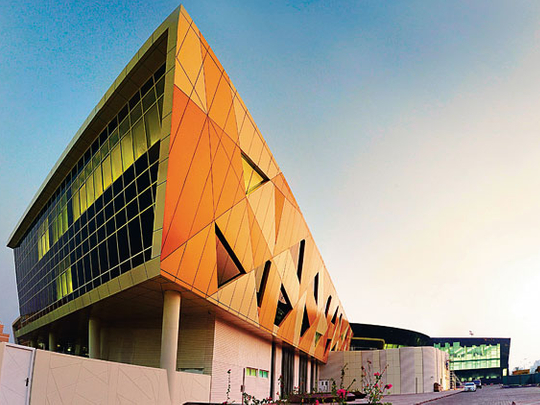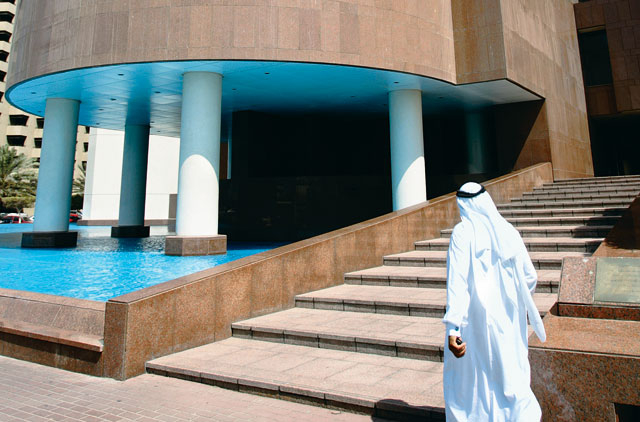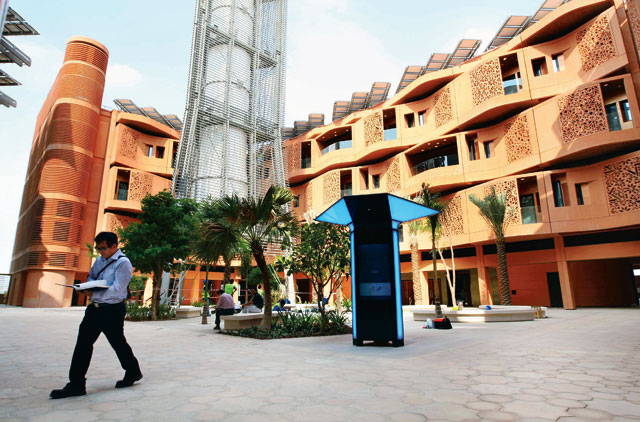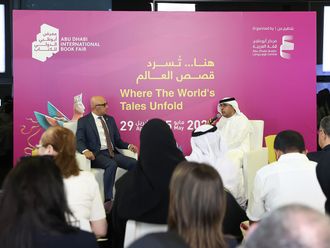
Architecture is not just about iconic buildings or funky designs that never see the light of the day. It is also about creating a sense of place, where the end user enjoys the interaction within the private and public realm of the project, the interplay of light and shade and above all, energy efficiency when it comes to utility bills.
And while a cut and paste approach to preserve tradition is not advised, the architect must also design keeping the social and cultural mores of the region, the context of the surrounding projects and the regional location when marching ahead with the times.
On the eve of UAE National Day, Gulf News asked various architects if there was a UAE style of architecture. Viewpoints differed since the UAE, and especially Dubai, has had its share of criticism about “growing too much, too soon.” Yet architects who have lived long enough in the region say that when the recession wanes, the UAE will be the forerunner in terms of certain criteria – good infrastructure, the Dubai Metro and the Estidama standards, which have given the UAE an identity of its own in the region in terms of being a forerunner in creating sustainability standards.
What emerged from the dialogue was that certain projects redefined the understanding of modern and broke away from the monotony of ‘me too’ designs. Yet others reinterpreted the traditional vernacular in a new approach. At the same time, the majority opined that the iconic Dubai World Trade Centre building has stood the test of time.
“To me, architecture in the UAE brings to mind Venturi’s theory regarding the “decorated shed”, where purely functionalist forms are adorned with decoration in order to create a more interesting form. This, in my opinion, is fake and not functional. Additionally, one cannot help but notice the city’s resemblance to the Las Vegas strip with a plethora of high-rise beautifully ornate towers that have not yet synchronised into a homogeneous whole; which truly establishes the distinctive and sustainable identity for the city,” says Ahmed Abdulrahman Bukhash, Chief Architect and Founder at Archidentity. American architect and author Robert Venturi, Jr, is one of the major figures in the architecture of the twentieth century. A winner of the Pritzker Prize in Architecture in 1991, Venturi, in his book Learning from Las Vegas: the Forgotten Symbolism of Architectural Form, coined the term ‘Duck’ and ‘Decorated Shed’ to describe the two predominant ways of embodying iconography in buildings.
“After driving down Shaikh Zayed Road, I cannot help but think how these buildings will age 50 years from now. In contrast with the beautifully aged original World Trade Center designed by John R. Harris in the 1970s with its framed windows and distinctively defined facade that duly function as a solar barrier and aesthetically pleases,” says Bukhash.
The UAE national, who is passionate about his country’s identity, says he continuously wonders what each architect has done to improve the local architecture of the UAE, but never finds an answer. “Certain buildings do stand out such as the original Dubai Municipality building,” he says. This was designed by Kazuyuki Matsushita who said that it would ‘inspire future prototypes through its timelessness which it has clearly achieved through its shaded courtyard prototype’.
Staying true to the culture
“While historically, the old UAE architecture was very different with its mud and brick houses, the design also followed the way families lived,” says Ammar Al Assam, Executive Director at Dewan Architects. “Wind towers cooled the interiors while courtyards were necessary to maintain privacy, which was always important. Then the oil boom and ensuing modernisation led to a new concept of contemporary style, which is sometimes mixed with traditional architecture. But in a more thematic manner as opposed to a functional approach — as seen in projects such as Madinat Jumeirah.”
Again, while most residential projects in the UAE are modern, the country still has villa communities with high walls for privacy or houses with courtyards. “Though Dubai is very contemporary and modern, our experience is that Abu Dhabi is slightly different. Though you have areas such as the Corniche, which also has the Central Business District with its high rise buildings, banks and contemporary hotels, there are still areas which are more conservative,” says Assam.
So have all the developments within Dubai gone wrong? “I would say no. There are many successful developments that elevate the stature of modern architecture within Dubai,” says Bukhash. “Most of these are commercial such as the Dubai International Financial Centre (DIFC), Rolex Tower, Capricorn Tower, Emirates NBD main
Headquarters by Carlos Ott, Emaar’s Burj Dubai district and the Marina Mall complex.”
Ammar also agrees that DIFC is a well planned project. “You have to give credit to the way it functions, the way the exterior spaces are covered and shaded, the nice water elements and how it treats the spaces,” he says. “We are very proud of certain projects we have done on a smaller scale such as the Al Bateen school in Abu Dhabi, which is based on new learning environments where the central courtyard is a very vernacular modern interpretation of what they call the oasis — where children will interact as well as study in an open area.”
Urbanisation of cities
One tends to think that UAE cities have developed only after the discovery of oil, says Samia Rab, coordinator for the Agha Khan Award or arch for Arabian Peninsula. “But urban forms have been around from the 17th century onwards along the coast of the Gulf,” she says. “There is a considerable amount of pre-modern cultural and architectural identity that is now being wiped out by modern urbanism. Within modern architecture, I hate to say that there
are very few projects that really address the social considerations in architecture.”
She votes for UAE architect Omran Al Owais’s Al Warqua’a Courtyard, a project that she says “tried to create a modernised interpretation of UAE traditional architecture quite successfully.”
However, Assam says one should consider the fact that good architecture normally takes decades to take shape in cities around the world. “It has been a short time in the UAE. While there are some buildings, which many architects will consider a mistake in terms of form and function, but that number is small when compared to all the successes. From mid-90s to now, the pace has been unbelievable. No other place would have experienced such growth in such a short time. What has become prominent in the last ten years in Abu Dhabi are hospitality projects that go back to the old traditional architecture — such as the Shangri-La and Qasr Al Sarab.”
However, Farid Esmaeil of X Architects says that Masdar as an overall development, especially the Masdar Institute, is a good example of contemporary and sustainable architecture that works together overall to enhance community and culture. Again, Central Market in Abu Dhabi is a sensitive project that makes good use of materials, he says. “In Dubai, the World Trade Centre is an authentic project, where the reference to the mashrabiya in the end becomes the skin of the building,” says Esmaeil.
According to Dr Shams Eldien Naga’s of Naga Architects, the Burj Khalifa is an impressive creation. “It is a clean building and an icon but does not take any articulation that is not required and hence, it is successful. Again, the Index Tower works in terms of proportion. It has a simple but elegant design and yet thinks forward,” says Naga.
Bab Al Shams, he says, is a good project but it is still traditional and could have benefitted from a slightly modern approach. “Royal Mirage is a good building in terms of proportion. Even after so many years, the Dubai Municipality is still a good building that is standing for its time, so also the World Trade Centre. These are iconic for Dubai — for the time that they have been built and still remain very well respected.”
Identity of UAE architecture
So where does the future lie? “Following the financial crisis of 2009 and within the field of residential architecture, a similar renaissance is being felt where clients are opting for more efficient principles of design and incorporating traditional elements of design. The crisis brought architecture back into the limelight, which was otherwise neglected,” notes Bukhash. “Also, there is an increased interest in local architects rather than expats since they have a better understanding of client requirements in terms of designing residential houses.”
Esmaeil feels sustainability is contributing to the UAE’s architectural signature. “In the past five years, there has been a great initiation from Masdar and the Estidama ratings (the latter being the first of its kind). It pushes the agenda for sustainability. This goes back to being contextual and responsive to the environment and culture,” he says. “Hence, the identity of UAE architecture is moving towards sustainability and contemporary design. International architects who come here are moving away from the cliché of looking at history in a copy paste way by just using certain elements.”
It’s a modern way of learning from history, he says. “International architects are looking at the contextual value of the historical typology and how that could be brought into a more contemporary manner for the future of the UAE. People live differently today. We have cars and cities that need to respond to this need. And yet there are certain values that need to be integrated into contemporary life,” he says.














